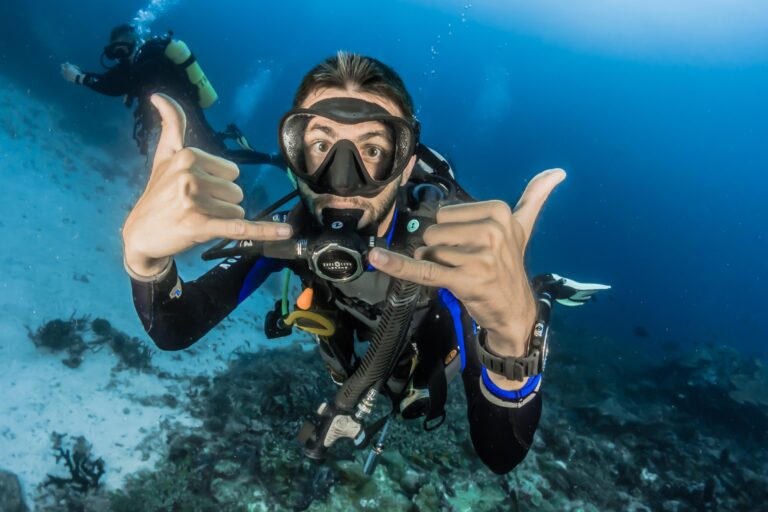Diving is one of the most fun and adventurous activities. Whether you are a beginner or an experienced diver, knowing how to use less air when diving will help you experience more underwater adventures. There are many factors that can contribute to your high consumption of air while diving such as not equalizing pressure in your ears, lung capacity, fitness level and equipment used. In this post we will discuss some tips for conserving air during dives so you can enjoy more time underwater!
Table of Contents
Big lung volume
The first thing is that people who have high lung volume, especially guys are more likely to consume a lot of air when diving. If you know your lung capacity before going on the dive, then make sure you take in less than what’s recommended for someone with higher lung capacity. For example, if you’re an experienced diver and your lungs are on average around 300-400 liters, then only take in 200 liters of air.
It is more relaxing to take deep breaths when you are diving.
It is more relaxing to take deep breaths when you are diving. It’s a myth that if you’re not breathing deeply, then your lungs will explode and come out of your mouth! You can breathe in and out slowly underwater as well as on the surface. If you feel like taking deeper breaths while diving, try exhaling before inhale ; this will give you a few seconds to take in more oxygen before your next breath.
Anxiety can lead to heavy breathing and air consumption.
When you’re nervous, your muscles tense up. When the body gets tense, it squeezes down on air passages. When this happens people may breathe heavily without realizing it and end up taking in a lot of air with each exhalation.
You can also use this to your advantage by breathing in through the nose and out of the mouth. Breathing from the diaphragm (belly button) is a natural way for humans to breathe, so it works well when you’re trying not to consume too much air. If you find yourself having difficulty taking deep breaths while diving, try slowing down or switching up your technique; it might make a big difference!
The faster you swim, the more air will be consumed.
This is because the body can’t process oxygen as fast when it’s working hard and breathing quickly. When diving in water that isn’t very deep or with no current, divers should try to keep their average speed about 20-30 feet per minute (depending on their experience level) so they don’t expend too much of their precious tank before reaching safety.
In some cases, a diver might need to go up for fresh air even if they’re not at danger point–if they’re traveling through an area where there are lots of marine animals around them; the extra bubbles from using less air may scare away those creatures which could spell disaster for both parties!
Buoyancy Control
The less air you use the better. There’s a way to control your buoyancy, and it starts with using less air so that you can stay submerged longer–and not be tempted to go up for more oxygen when there are fish around!
For some people, this is easier said than done; they need to breathe out a lot just to stay down!
But if they try practicing their breathing technique before diving- getting used to exhaling slowly rather than holding everything in as long as possible- then they should find themselves staying at depth without much effort.
From here on, every time divers head underwater or begin their descent into freshwater from saltwater (this changes the density of objects), they should try keeping an eye on how much air is in their tank before continuing.
It’s a good habit to start because the more you dive below fifteen meters and for longer than two minutes at any depth, the greater your risk of decompression sickness or DCS (a group of disorders that can occur from too much nitrogen getting into the system).
Use too much air when fighting currents
Divers should never fight the current when they are diving. Instead, they should swim with it and stay parallel to the surface as much as possible while still being able to move in a direction of interest to them.
This way, their air consumption will decrease dramatically because of how less effort is required for swimming against currents than going with them.
Regulator tuning
Tuning your regulator to suit your diving style will help you save air. Some regulators are more suited to deeper dives and some will be better for shallow movements. Divers should know which kind suits them before purchasing the product.
Regulators vary in price, but generally good ones start around $400. If you’re looking for a cheaper alternative then find a regulator tuning kit that includes substances like silicon or rubber to help make adjustments without compromising your air supply too much.
One way divers have historically tuned their regulators is by using substances like silicon gel or rubber tubing over the mouthpiece opening. These materials help make adjustments easier without compromising too much on an adequate air supply.
Dive deep than other
the deeper you dive, the more air you will consume. This is because the air pressure decreases as you dive deeper.
Divers should also be aware that when they are diving at a shallower depth, their regulator will need more tuning to compensate for less air pressure on their body. Again, this can affect your oxygen supply and lead to hyperventilation
It’s important to know how deep you’re going before each dive so you plan accordingly for currents or any other factors which might affect the bottom time of your dives
The Bottom Line
We hope this post has given you some helpful tips for conserving air while diving. With these few simple tricks, we know that your next dive will be an enjoyable one! If you have any questions about anything mentioned in the article or would like to chat more with our team about what gear is best for beginners and experienced divers alike, don’t hesitate to reach out to us at info@scuba-do.com

